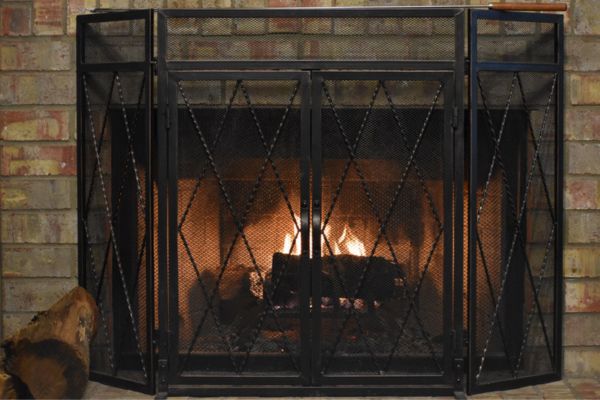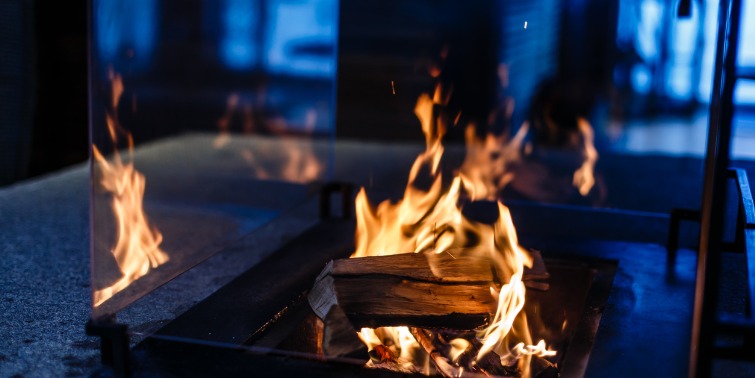Nothing is as cozy and comforting as a fireplace or wood stove fire on a cool night. The gentle flames can be mesmerizing as they dance and glow. However, this serene experience can sometimes be interrupted by a sharp pop that sounds almost like a gunshot, often accompanied by a spark or a small piece of burning wood flying out of the fire. Additionally, your fire may produce continuous snapping sounds, which can be loud and a bit frightening. While some fires are quieter, they often still emit a constant crackling sound. But why does firewood pop? The popping, snapping, and crackling of a fire are the results of the physical and chemical reactions that occur when firewood burns.
Why Does Firewood Pop?
A wood fire can be mesmerizing and beautiful, but it is also a complex chemical reaction. Why does firewood pop? As wood burns, the cellulose and lignin within it break down in a process known as pyrolysis. The gases released during this process make the fire orange and produce a snapping and crackling sound. In addition to these wood resins, firewood contains small amounts of water trapped in the deep grains of the fibers. This water turns to steam when heated in a fireplace or wood stove. As the steam and other gases expand, pressure can build up until it bursts, creating a loud, sharp popping sound. Along with these popping noises, wood particles or glowing embers may fly out of the fire. These lit embers can land on nearby items and scorch, melt, or burn your belongings—or even cause injury to you.
Moisture content in wood plays a significant role in both physical and chemical reactions during combustion. The higher the moisture content, the more the wood tends to pop and crackle when it burns. If you’ve tried burning freshly cut wood, you may have noticed that it can be difficult to ignite and produces a lot of noise once the fire finally catches. Wood tends to have a high moisture content if it is not properly dried or “seasoned,” and some types of wood have a much higher moisture content than others.
Noisy Ones: Types of Firewood That Pop the Most
Since trapped gases and steam make a fire pop and snap, woods with a higher moisture content or more resin are likely to produce more noise. Some woods are particularly notorious for popping and snapping. Why does firewood pop?
Osage Orange or Hedge
This dense hardwood has an exceptional amount of sap in its fibers. When burned, this sap becomes gaseous and is continually released with a loud snap or pop. Sitting in front of an orange wood fire can feel like a fireworks display– it really puts out the noise and sparks. Osage orange wood is an excellent choice if you are looking for a loud fire. For those wanting a quieter experience, this wood is a bad choice.
Pine
Pine contains a lot of resin, and some types of pine contain extremely high amounts. Eastern white pine is an example of a pine variety that is exceptionally high in resin. This resin can sometimes create a pleasant crackling sound and produce a flame that pops and spits out sparks. For this reason, many people find that high-resin pine is not suitable for an open fireplace. If a higher resin wood is ever burned in an open fire, it is a good idea to use a fire screen for safety reasons.
Douglas Fir
Softwoods are generally much noisier. So why does firewood pop? It’s because they are less dense and have a higher sap content. Douglas Fir is no exception. A Douglas Fir fire can be loud, with many snaps and pops.
Black Locust
This dense hardwood creates a modest amount of crackling and snapping. Because it burns so slowly, it is a good choice for those who want a crackling fire without the snapping and popping of softwoods like pine or fir. Black locust creates a hot fire with just enough noise to please those who like a crackling fire.
The noisiest firewoods will be softwoods with a high resin content and hardwoods with exceptionally high sap levels.
Quiet Ones: Types of Firewood That Pop the Least
On the other hand, some firewoods are silent partners, providing very little noise. These quieter firewoods include:
Oak
Who doesn’t love a fire made with oak firewood? Oak is a very dense wood that burns slowly. If you correctly season or dry oak, it produces an exceptionally quiet and steady flame. Unfortunately, oak takes a long time to season naturally, so kiln-drying is particularly helpful for getting oak firewood that burns quietly and efficiently.
Maple
Maple firewood burns steadily and slowly, with minimal popping and snapping. It is lighter than oak and dries more quickly. While it is possible to dry maple naturally, kiln-dried maple produces more consistently good firewood. For a quiet fire that makes a lot of heat, it is hard to beat maple firewood.
Birch
Birch has been a favorite firewood for generations. Like many hardwoods, it has a quiet burn and contains little resin. However, if not properly seasoned or kiln-dried, birch can snap and pop due to its higher moisture content.
Choose hardwoods with low sap content if you prefer a quieter fire that doesn’t snap or pop. But why does firewood pop? The type of wood isn’t the only factor affecting your fire’s noise level. The condition of the wood is also important; you should use firewood that is either seasoned or kiln-dried. This seasoning or drying process helps to eliminate moisture, resulting in a quieter fire.
 Benefits of Kiln-Dried Firewood
Benefits of Kiln-Dried Firewood
Kiln-drying reduces moisture in wood and, consequently, the noise created by moisture. A quiet and efficient fire requires good, dry firewood. Many people prefer kiln-dried wood, but wood also dries naturally over time through an outdoor seasoning process.
A kiln is a large, heated area or oven that heats large amounts of wood to evaporate moisture. To burn efficiently, firewood should have no more than 20 percent moisture content. Believe it or not, freshly cut wood can have a moisture content as high as 50 percent. Kiln drying produces firewood with fewer resins and moisture, which results in less creosote and minimal smoke.
Bugs being incinerated can sometimes cause the crackles and snaps you hear from a fire. An added benefit of kiln drying is that it eliminates pests. Naturally dried firewood may come with insects and pests, but the kiln drying process kills these unwanted visitors. As a result, you can store kiln-dried firewood indoors, which helps keep it dry.
While seasoning wood outdoors is always an option, kiln-dried wood is drier and can have an exceptionally low moisture content, sometimes as low as 10 percent. This level of dryness is not achievable through outdoor seasoning. Due to its low moisture content, kiln-dried wood produces less snapping, popping, and crackling compared to other types of wood. Compared to seasoned wood, kiln-dried wood is quieter, cleaner, and safer.
Strategies For a Safe and Pleasant Fire
To produce a good fire that burns steadily and quietly, you need a good choice of seasoned or kiln-dried firewood. But there are other strategies for a fire that does not pop or snap.
Choose smaller pieces of wood.
Smaller logs or pieces of firewood will produce a quieter fire. Some noise heard during the burning process is the sound of wood splitting as the gases inside the wood build up. To minimize this, use a smaller piece of firewood.
Construct your fire for proper airflow.
As you build your fire, arrange it for proper airflow. When a wood fire has airflow, it will burn efficiently and completely, producing less ash and creosote and less popping and crackling. A damper or air vent can control airflow in a fireplace or wood stove.
Use a Fire Screen.
If you are burning in a fireplace or fire pit, use a fire screen. This is especially important if you are burning softwood with a lot of resin, like pine or fir. A fire screen can prevent burning embers from damaging your belongings or, worse yet, burning you or someone you love.
With these strategies, you can produce a good and safe wood fire that burns quietly and efficiently.
Get Premium Kiln-Dried Firewood in Rochester Today!
Some people prefer a crackling sound when they sit watching a fire. But sudden pops or snaps can be jarring and can be dangerous if they create popping embers. To minimize snapping and popping, select the right variety of firewood and ensure it is well-seasoned or kiln-dried. Kiln drying is particularly effective at drying out firewood and creating a quiet and safe fire.
ProCut Firewood offers premium kiln-dried firewood for a quieter and safer fire in your home. We take pride in providing excellent customer service to the Rochester and Twin Cities areas. Contact us today to ensure you receive the highest quality firewood available.







